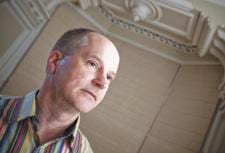
Director Charles McFarland. Credit: Paul Galipeau
If Hamlet, Prince of Denmark, were to write an epitaph for his loyal companion Horatio, it might say something like, “He was a great listener, a great friend, a great lover… uh, you know.”
A new version of Shakespeare’s oft-quoted tragedy premieres at Centrepointe Theatre’s 250-seat studio, a recent addition to the performing arts complex in Ottawa’s west end.
Appropriately titled Hamlet 2011, the production considers, perhaps more than any other in recent history, the homoerotic relationship between the eponymous character and his devoted Horatio. This is a task that befits the newly formed Ottawa Shakespeare Company (OSC), an ensemble managed by three gay theatre practitioners: director Charles McFarland and actors Michael Mancini and Scott Angus Wilson.
“Leading a theatre company is totally new for me,” says Mancini, cast in the role of Hamlet. “But I think many artists get to that stage where you want to create your own work. Waiting for a theatre company to offer you a role is fine, but I don’t always want to wait.”
Having worked with McFarland on several Ottawa productions, most recently Third Wall Theatre Company’s Henry V (again, playing the title role) and the Great Canadian Theatre Company’s The Optimists, Mancini has developed a strong working relationship with the veteran director that has morphed into an artistic partnership.
“We worked for many years together, Charlie and I. And we kept coming back to Shakespeare,” explains Mancini, who believes that this new company will provide stimulating opportunities for local thespians. “If we can do one thing in Ottawa, we should be giving actors more work.”
Completing the theatrical triangle is Wilson, a Toronto-trained actor who has performed at the Stratford Festival and who moved to Ottawa just over three years ago. He performed with Mancini in Henry V and found a kindred spirit in his acting partner: “I love working with Michael. I rarely work with an actor with whom I have an instant connection. I trust him implicitly. We have a wonderful dynamic,” says Wilson, who plays Horatio.
Recognizing further potential in Horatio, director McFarland adapted the script to spotlight his role as Hamlet’s storyteller, mainly by having Horatio play narrator in the opening scene. While Horatio is overlooked in many productions and reviews, viewed only as a “straight” character to complement Hamlet’s seemingly mad one, Wilson suggests there is much to explore: “It’s an interesting role because he’s the only one that Hamlet truly confides in. There’s this explicit relationship between them that I don’t think has been explored. In this show, it’s a struggle for Horatio to see Hamlet pursuing Ophelia,” says Wilson.
“He’s the only one who’s really there for Hamlet. Their relationship was maybe at one moment much closer, perhaps deeper than most Elizabethan relationships among males,” suggests Mancini.
This relationship is explored not only in the production itself, but also in a teaser video available on YouTube: it depicts a modern-day Hamlet donning a paranoid disposition at a swanky party, then finding himself in bed with Ophelia, only to be awoken to the news of his father’s death, as delivered by a cautious Horatio. The following exchange between Hamlet and Horatio is particularly memorable:
“Are you decent?”
“Not usually. Come in.”
All three artistic leaders of the OSC have collaborated for months on this production, meeting once a week to discuss the script’s nuances and shape a vision for the show. Now they step into the rehearsal studio to collaborate with the rest of the ensemble.
“This month I will be at work during the day and rehearsing until 10pm. My fiancé is not happy!” jokes Wilson.
Although Wilson and Mancini are trained and experienced actors, they both maintain day jobs — as an investment advisor at RBC Dominion Securities and in a marketing department with the federal government, respectively — that allow them to connect with people, resulting in something not unlike the connection that is achieved in a theatrical setting.
“I interview business people and create podcasts and videos. This is a job that has allowed me to be an actor for the past 12 years. I love what I do here; it’s really creative. Plus, my partner and my two kids have dental plans!” says Mancini.
Both actors look forward to witnessing the audience response to Hamlet 2011, hoping to challenge the assumption that Shakespeare’s texts are inaccessible. Wilson insists, “It’s not stuffy art, not academic. Sure, we’ll do all that art behind the scenes, but we are producing it for them, the audience. We are saying that Shakespeare is great; it’s sleek; it’s guttural. You’re going to love it.”

 Why you can trust Xtra
Why you can trust Xtra


